Alcon Research 212WIFI WLAN 802.11b/g in Constellation Vision System User Manual NGVS Book 1 indb
Alcon Research Ltd. WLAN 802.11b/g in Constellation Vision System NGVS Book 1 indb
Contents
User Manual part 3
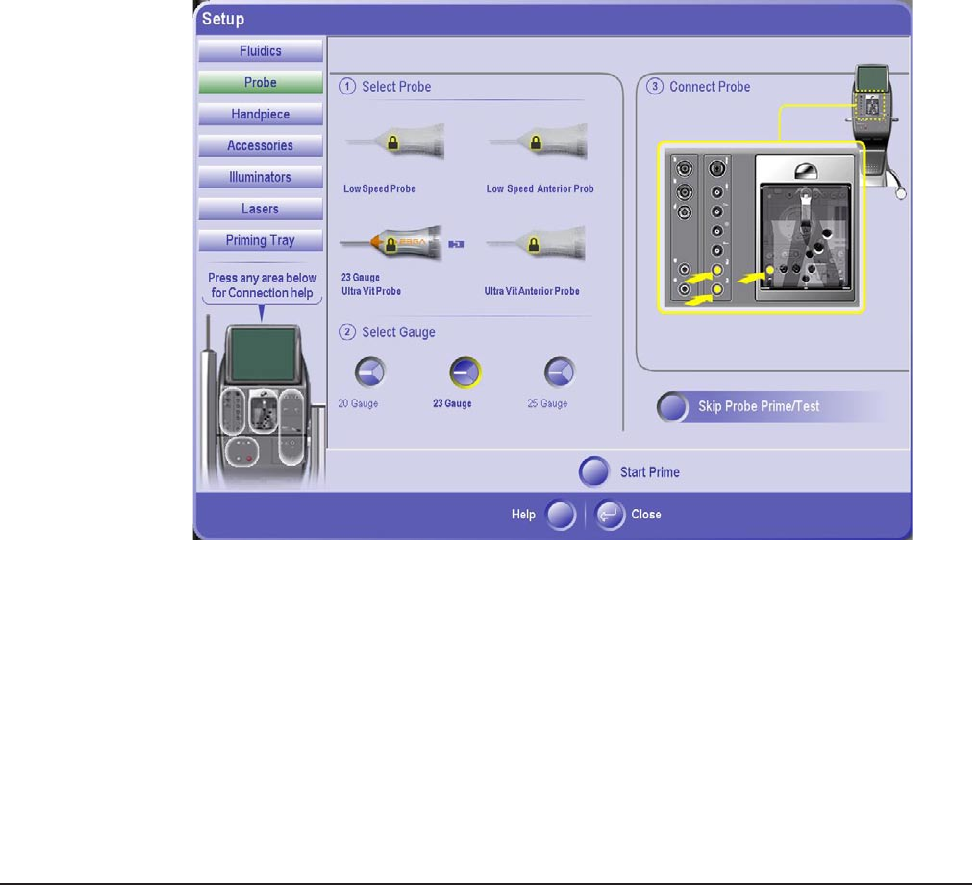
2.50 8065751025
Constellation® Vision System
Detailed Setup: Probe
The Probe setup panel shown in Figure 2-38 displays the steps required to properly
connect the various vit probes to the system.
Select Probe - Provides a selection of probes and, when a probe is selected, shows
where to connect to the front panel. When the system detects that the operator
has plugged in the probe, the handpiece type is automatically selected, the
“connected” icon appears next to the selection list, and the selection list is locked.
Select Guage - When a probe is selected, the Select Guage section offers three
options: 20, 23, and 25 guage. Once selected, the selected guage size appears
under the selected probe.
Connect Probe - This section shows an illustration of the connector panel and
highlights the connections for the selected probe.
Skip Probe Prime/Test - Indicates whether the operator wants to skip priming the
selected vitreous probe. When the checkbox is checked, the system will not prime or
test the vitreous probe when the user requests Prime & Test.
1.
2.
3.
Figure 2-38 The Detailed Probe Setup Panel
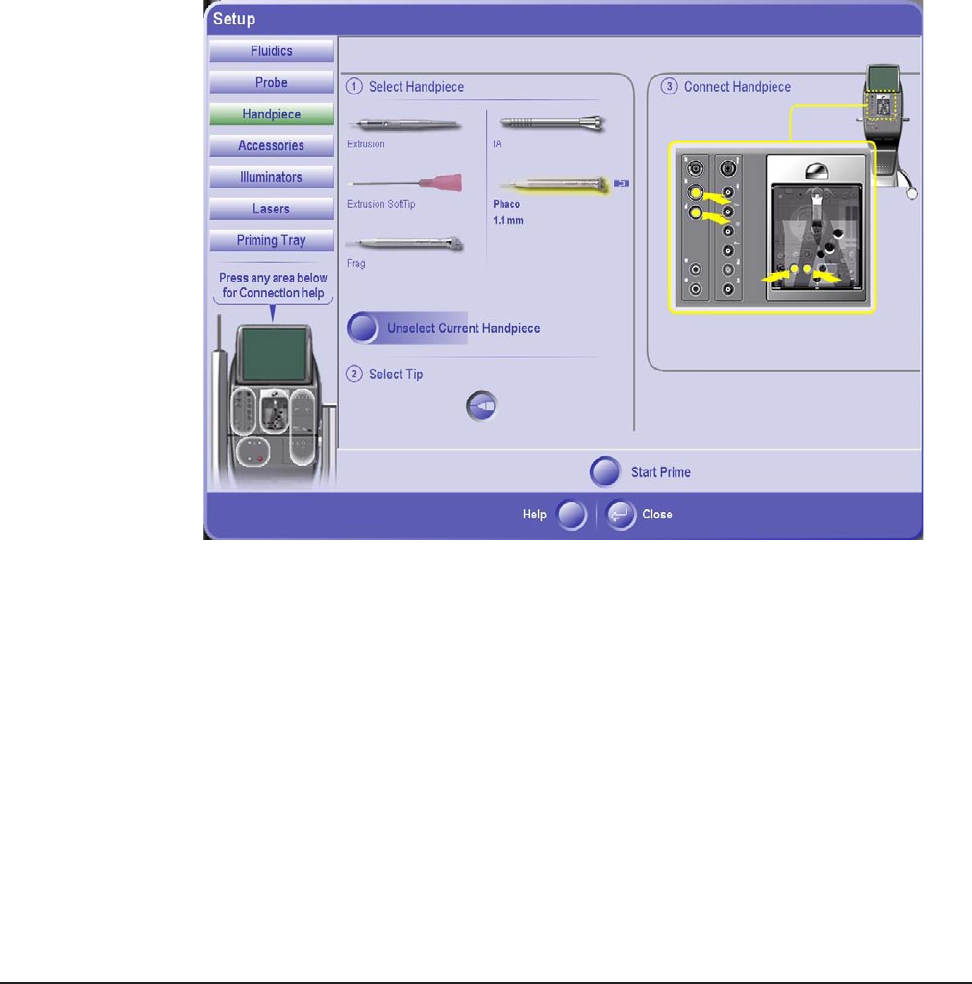
8065751025 2.51
Constellation® Vision System
Detailed Setup: Handpiece
The Handpiece setup panel shown in Figure 2-39 displays the steps required to
properly connect the various handpieces to the system.
Select Handpiece - Provides a selection of handpieces and, when a handpiece is
selected, shows where to connect the handpiece. When the system detects that
the operator has plugged in the handpiece, the handpiece type is automatically
selected and the “connected” icon appears next to the selection list.
Select Tip - When a handpiece is selected, the Select Tip button appears and
pressing the button opens a popup that will show a variety of tips that can be
selected. Once selected, the tip will appear under the selected handpiece.
Connect Handpiece - This section shows an illustration of the connector panel and
highlights the connections for the selected handpiece.
1.
2.
3.
Figure 2-39 The Detailed Handpiece Setup Panel
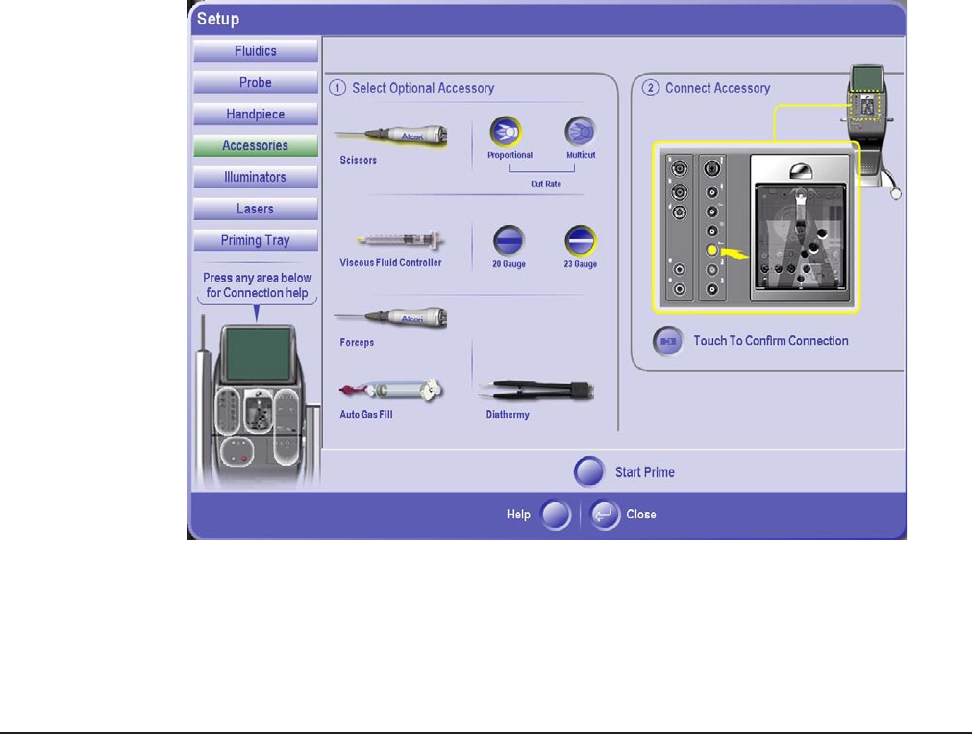
2.52 8065751025
Constellation® Vision System
Detailed Setup: Accessories
The Accessories setup panel shown in Figure 2-40 displays the steps required to
properly connect the following accessories:
Scissors
Viscous Fluid Controller
Forceps
Auto Gas Fill
Diathermy
Select Optional Accessory - Provides a selection of accessories and, when an
accessory is selected, shows where to connect the accessory. When the system
detects that the operator has connected the accessory, that accessory type is
automatically selected and the “connected” icon appears next to the selection list.
Confirm Connection - This button is present when the user has selected an
accessory that is not currently detected as connected by the system. When this
button is pressed, the system assumes that the currently selected accessory has
been connected (even though it was unable to detect it). However, since the
system did not auto-detect the connection, it will not lock the user from selecting
the type of the accessory (e.g., type of scissors).
Connect Accessory - This section shows an illustration of the connector panel and
highlights the connections for the selected accessory.
•
•
•
•
•
1.
2.
Figure 2-40 The Detailed Accessory Setup Panel
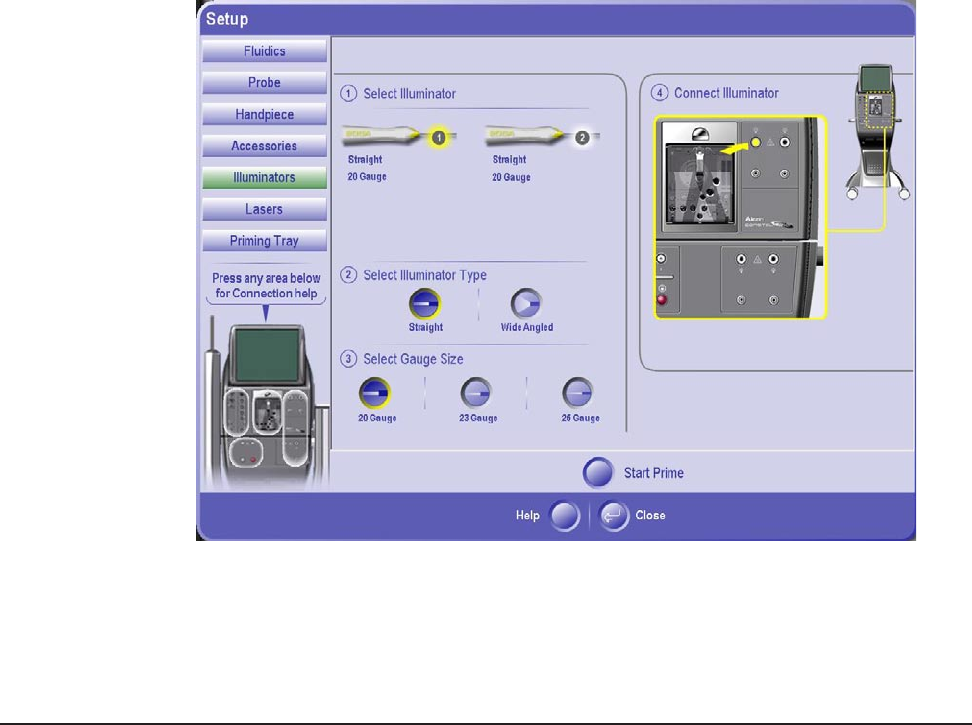
8065751025 2.53
Constellation® Vision System
Detailed Setup: Illuminators
The Illuminators setup panel shown in Figure 2-41 displays the steps required to
properly setup and connect illuminator probes to the front panel.
Select Illuminator - Provides a selection of illuminator probes and shows where
to connect the probe. When the system detects that the operator has connected the
illuminator probe, that probe is automatically selected and the “connected” icon
appears next to the selection list.
Select Illuminator Type - Shows the Illuminator probe type the operator has
chosen and/or inserted for the highlighted illuminator port.
The following illuminator probes are selectable:
• Straight
• Wide Angled
Select Gauge Size - This control is only available when the an illuminator type
has been selected. When the guage size is selected, it is displayed under the
selected probe. The following illuminator gauge sizes are selectable:
• 20 Gauge
• 23 Gauge
• 25 Gauge
Connect Illuminator - This section shows an illustration of the connector panel
and highlights the connections for the selected probe.
1.
2.
3.
4.
Figure 2-41 The Detailed Illuminator Setup Panel
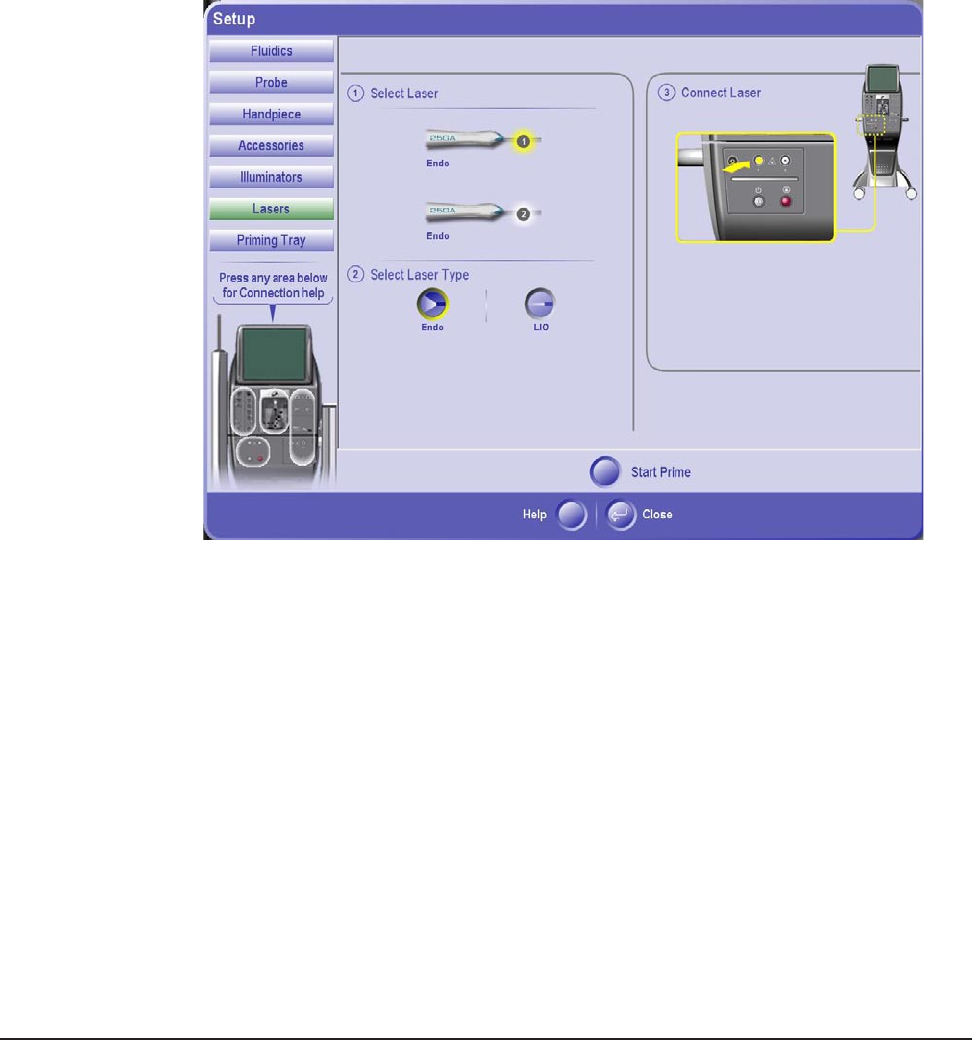
2.54 8065751025
Constellation® Vision System
Figure 2-41a The Detailed Laser Setup Panel
Detailed Setup Screen: Lasers
The Lasers setup panel shown in Figure 2-41a displays the steps required to properly
setup and connect endoprobes or an Laser Indirect Ophthalmoscope (LIO).
Select Laser - Provides a selection of laser options and shows where to connect
the selected option.
Select Laser Type - Shows the Laser type the operator has chosen and/or inserted
for the highlighted laser port. The following laser types are selectable:
• Endo
• Laser Indirect Ophthalmoscope (LIO)
Connect Laser - This section shows an illustration of the connector panel and
highlights the connections for the selected laser option.
1.
2.
3.
Detailed Setup: Video Help
When Video Help is selected, the popup shown in Figure 2-42 is displayed offering
list of help topics. Once the topic is selected, the user can choose between Video
Help and Wizard Help. Pressing the Video Help button launches a help video (see
Figure 2-43) that plays completely through the help video for the selected topic.
Wizard Help (see Figure 2-44) plays the same video but stops at various points to
give the user a chance to perform the required actions before continuing.
The controls on the Video Help Display operate as follows:
Start - Places the video at its beginning.
Rewind - Rewinds the video one segment.
Play/Pause - This button is labeled Pause when the video is playing and Play
when the video is not playing.
•
•
•
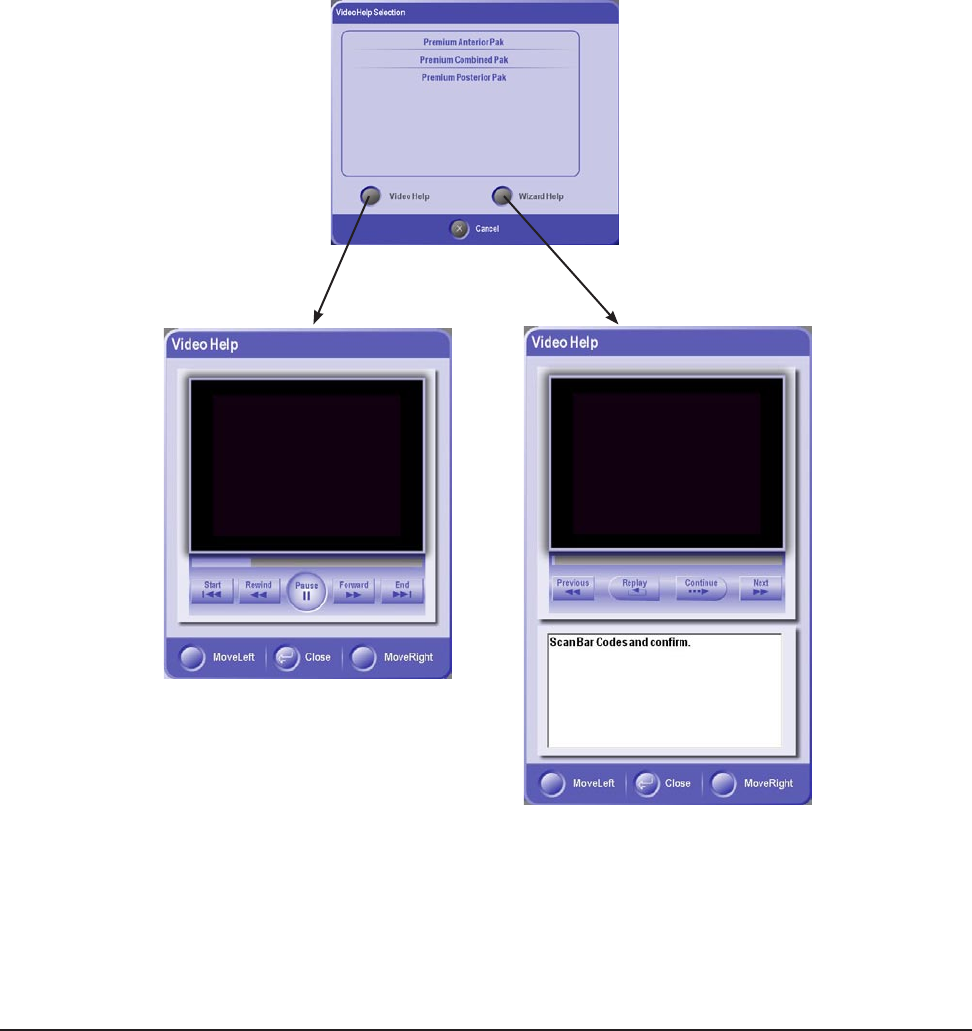
8065751025 2.55
Constellation® Vision System
Forward - Forwards the video to be forwarded one segment.
End - Forces the video to be forwarded to the end.
Move Left - Moves the entire video popup to the left side of the surgical panels.
Move Right - Moves the entire dialog to the right side of the surgical panels.
Close - Closes the popup and does not launch the Video Help dialog.
The controls on the Wizard Help Display operate as follows:
Previous - Rewinds the video one segment and play stops.
Replay - Rewinds the video one segment and play continues.
Continue - Resumes video play.
Move Left - Moves the entire video popup to the left side of the surgical panels.
Move Right - Moves the entire dialog to the right side of the surgical panels.
Close - Closes the popup and does not launch the Video Help dialog.
•
•
•
•
•
•
•
•
•
•
•
Figure 2-42 Video Help Popups
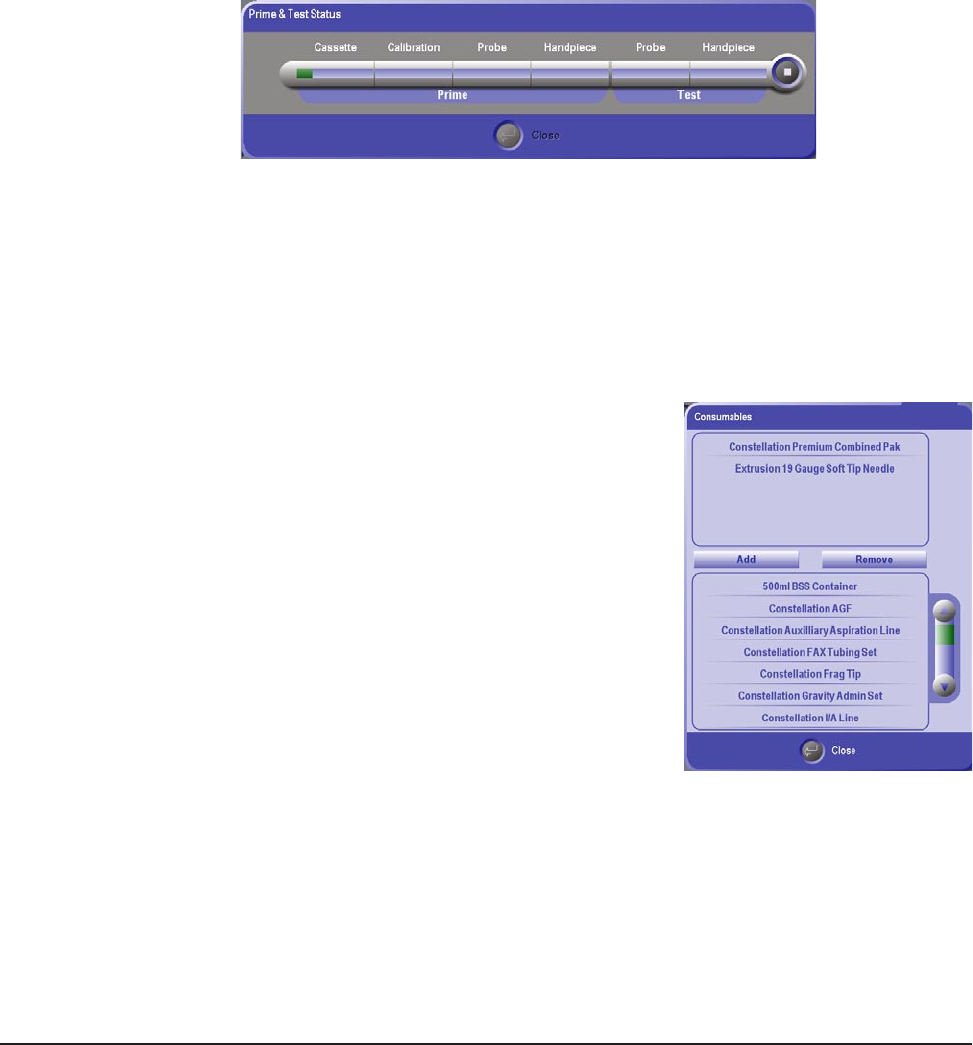
2.56 8065751025
Constellation® Vision System
Start Prime Button And Popup
After the instrument connections are complete, pressing the Start Prime button
displays the Prime & Test Status popup (see Figure 2-43) and begins the prime/test
process for the current setup. The status bar uses different colors to indicate the
progress and completion status of each segment of the prime/test process.
Partial green bar - indicates that the current segment is in progress.
Complete green bar - indicates that the process related to that segment has
finished with no errors.
Yellow bar - indicates that the user has cancelled the process by pressing the Stop
button at the end of the bar.
Red bar - indicates that the process related to that segment has failed with errors.
•
•
•
•
Figure 2-43 Prime & Test Status Bar
Consumables Button And Popup
Pressing the Consumable button displays the popup shown in Figure 2-44. In the
Consumables popup the user can view, add, or remove the consumables used for the
current surgical case. The top of the popup displays
the items that have been added to the current
case either through this popup or the bar code
scanner. The bottom of the popup shows the list of
consumbles that can be added to the case. Scrolling
through the consumables list is accomplished using
the scroll bar and arrows next to the list.
To add an item: Select the item from the
consumables list in the bottom of the popup then
press the Add button. The selection will be added
to the top list as an item used for the current case.
To remove an item: Select the item from the list in
the top of the popup then press the Remove button.
The selection will be removed from the top list.
Figure 2-44
Consumables Popup
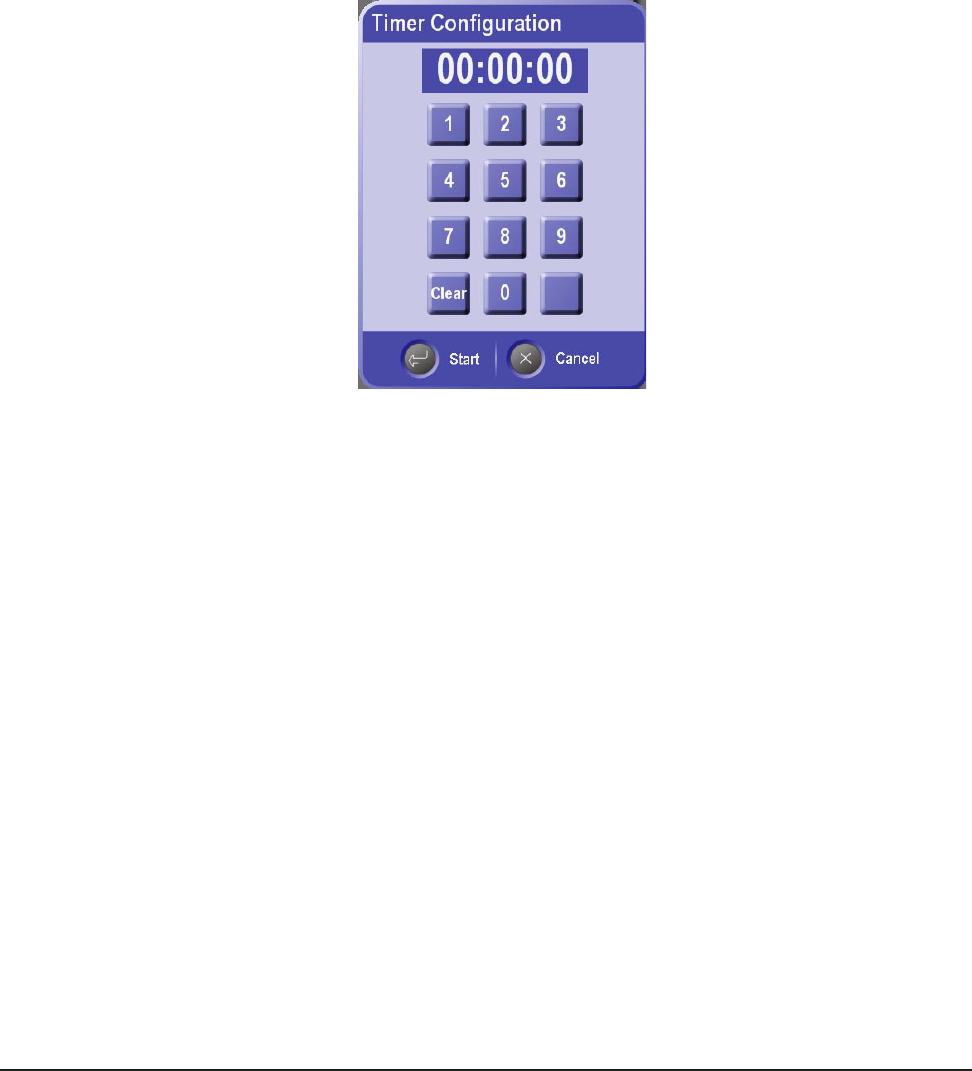
8065751025 2.57
Constellation® Vision System
The General Purpose Timer
Pressing the Timer Tab (00:00:00) next to the Consumbles button displays the Timer
Configuration popup shown in Figure 2-45. The timer provides for counting up
and counting down from a pre-configured value. The timer features the following
functionality:
Pressing the timer tab when it is running will stop the timer.
Pressing the timer tab when it is not running will launch the Timer Configuration
popup.
Pressing the Start button starts the timer and closes the popup.
If the timer is started when the readout is 00:00:00, it will count up indefinitely.
For countdown mode, enter at starting time using the keypad then press Start. The
timer generates an audible tone when it reaches 00:00:00.
•
•
•
•
•
Figure 2-45 Timer Configuration Popup
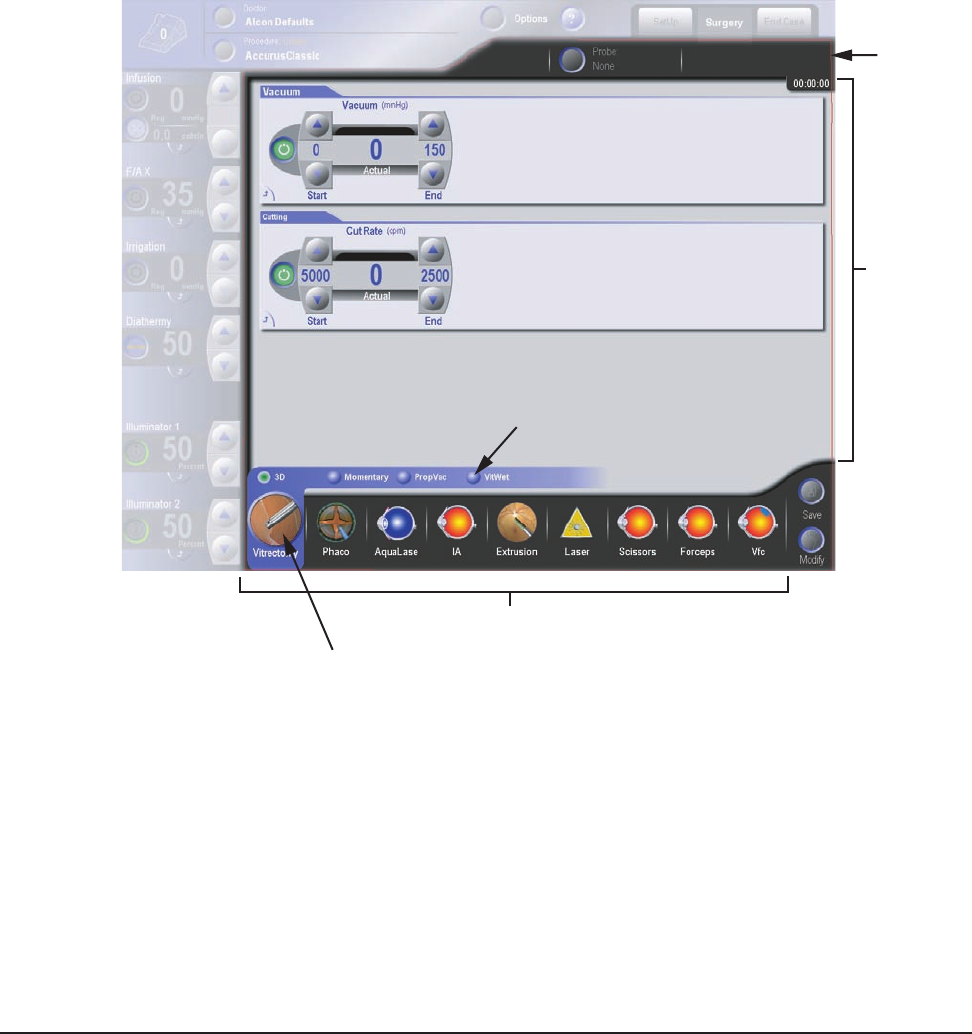
2.58 8065751025
Constellation® Vision System
SURGERY SCREEN
The Surgery Screen shown in Figure 2-46 is organized in the following way:
Menu Bar - This menu bar is context aware and changes the options depending on
the surgical mode.
Surgery Panels - Each Surgery Panel corresponds to a “Surgical Function” and
contains the various controls necessary to control each function.
Step Panel - The Step Panel allows the user to select Surgical Modes and
Submodes by pressing a Step Button and a Submode Button. The look of the Step
Panel depends on which Surgical Procedure (discussed later) is selected.
Save Button - The Save button opens the Quick Save dialog.
Modify - The Modify button opens the Modify Procedure dialog.
•
•
•
•
•
Menu
Bar
Surgery
Panels
Step Panels
Step Button(s)
Submode Button(s)
Figure 2-46 The Surgery Panel
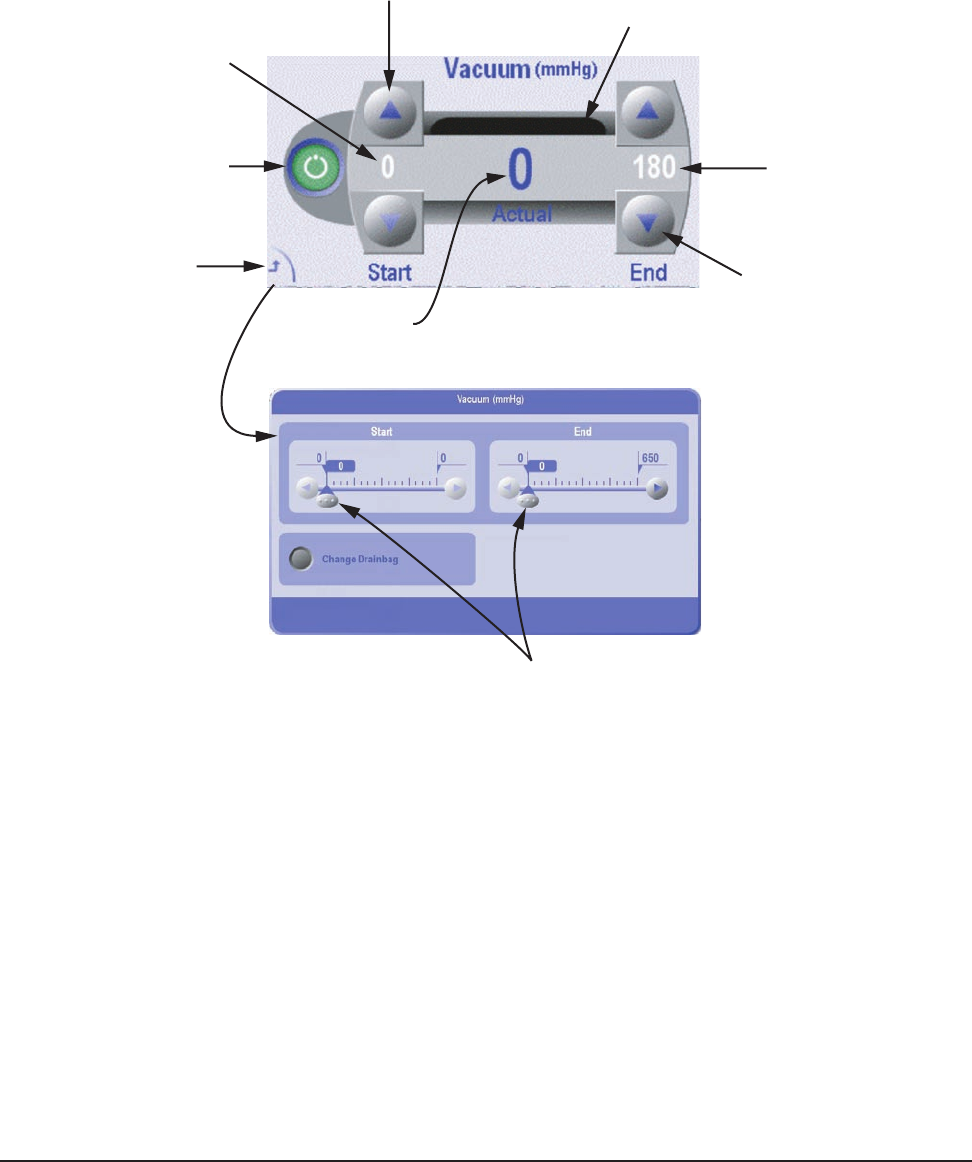
8065751025 2.59
Constellation® Vision System
Surgery Screen: Surgical Controls
The surgical panels make use of the surgical controls to change the values of the
associated surgical functions. The controls provide a variety of information and
capability to the user. As an example, the Vacuum control is shown in Figure 2-47.
On/Off
Button
Detailed
Settings
Button
Actual
Value
Start
Value
End
Value
Slider Controls
Increase
Setpoint
Value Button(s)
Progress Bar
Decrease
Setpoint
Value Button(s)
Figure 2-47 Vacuum Control and Settings Popup
The surgical controls contain some or all of the functionality described here:
On/Off Button– Toggles the function on and off. A green button indicates that the
function is on while a dark gray button indicates that the function is off.
Up/Down Arrow Buttons – Increase/decreases the associated setpoint value. The
button face indicates whether or not the associated setpoint can be increased or
decreased. The button is disabled when increases/decreases are not allowed.
Start Value – Shows the current setpoint at the treadle starting position.
End Value - Shows the setpoint at full treadle. Note that the Start and End objects
always control the same function and that their states (pressed or raised) always
track.
•
•
•
•
Settings Popup
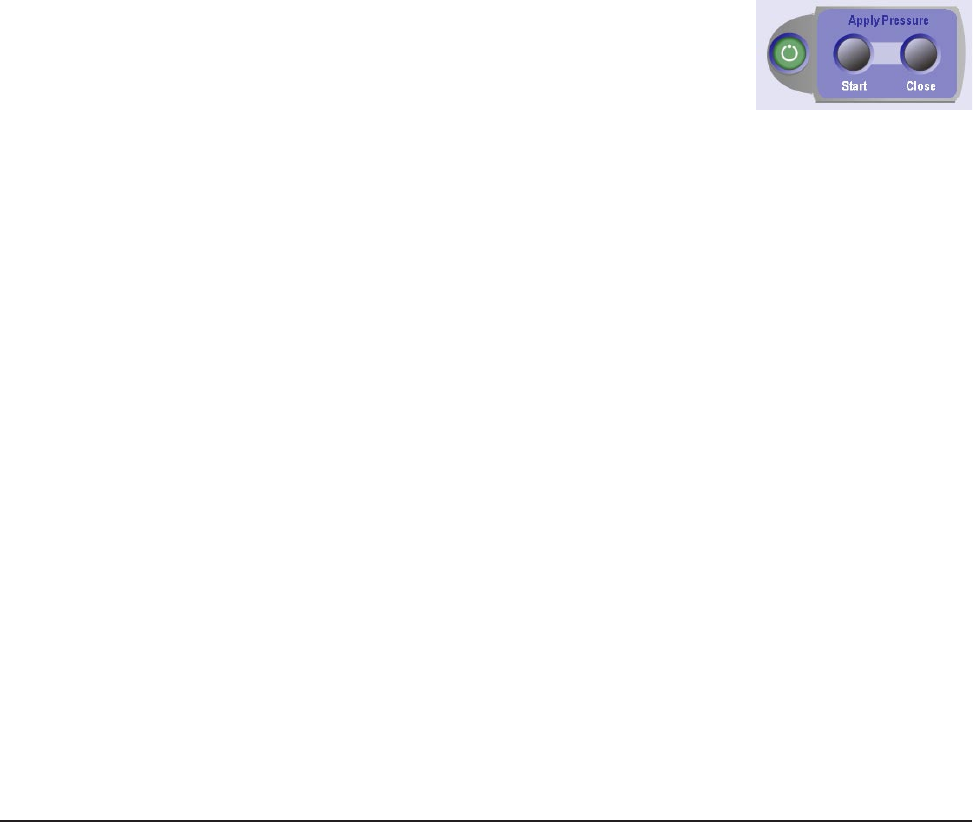
2.60 8065751025
Constellation® Vision System
Actual value – Displays the current value of this parameter and depends on the
position of the footswitch treadle. The actual value is shown as an absolute value
and also as a relative percentage of the maximum via the progress bar.
Surgical function name – The value displayed represents the surgical function
being manipulated by the On/Off or Action buttons.
Settings Button - Pressing the Settings button displays the Surgical Control
Settings popup where the setpoint values can be changed greater detail.
Slider Controls - On the Detailed Settings Popup, the slider controls adjust a value
by pressing and dragging the slider to the desired value location.
The Start and End buttons have the following characteristics:
In 3D submodes, both start and end values are independently adjustable.
In Linear submodes, only the start value is locked at 0.
In Fixed submodes, the start and end value are always the same, regardless of
which of the values is modified.
Surgery Screen: Surgical Controls - Settings Popup
When the Settings button is pressed on a surgical control, a Surgical Control Settings
Popup is displayed as shown in Figure 2-47 (Vacuum Setting shown in this example).
Settings modified here take effect immediately (i.e. before the user exits the dialog.)
Also, each control will have a slightly different popup given that some controls have
more functionality than others.
Surgery Screen: Surgical Controls - Surgical Control Options
For some surgical configurations, such as calibrating
scissors, it is necessary to provide additional options as
shown in Figure 2-48.
On/Off button - Toggles the option On and Off. This control is disabled when the
functionality is not available.
Left Option button - Allows the user to initiate the function assigned to this button
("Start" in Figure 2-48).
Right Option button - Allows the user to initiate the function assigned to this
button ("Close" in Figure 2-48).
•
•
•
•
•
•
•
•
•
•
Figure 2-48
Surgical Control Option
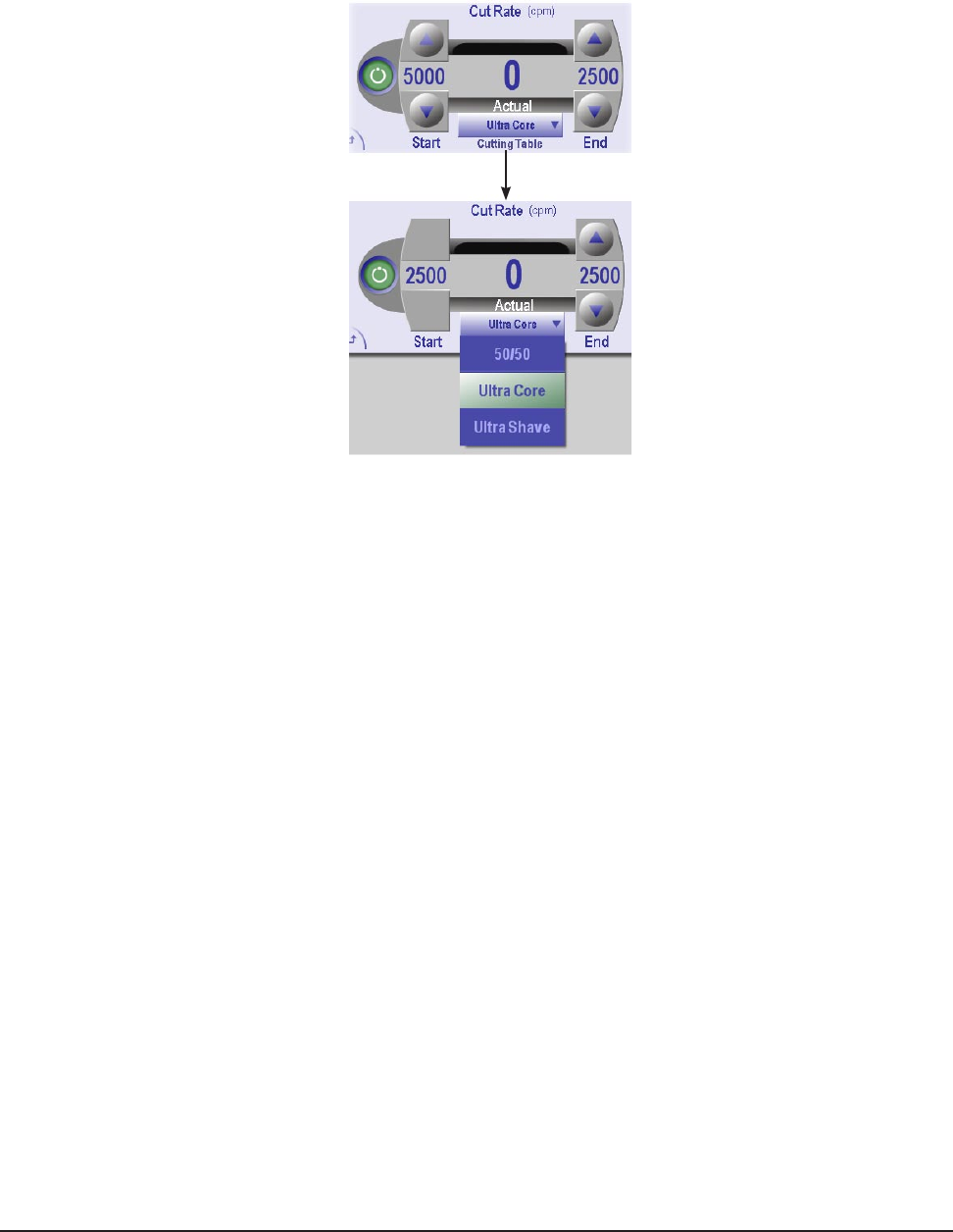
8065751025 2.61
Constellation® Vision System
Surgery Screen: Surgical Controls - Surgical Control Drop Lists
For some controls in certain configurations it is necessary for the user to define
additional parameters. Such parameters might include the Cutting Table, whether
Linear or Fixed Flow is desired, or dynamic rise time among others. When such a
choice is needed, a drop list appears near the surgical control as shown in Figure 2-49.
Surgical Control with
dropdown list.
Dropdown list
expanded.
Figure 2-49 Surgical Control with Dropdown List (Advanced Display Mode)
NOTE: The control is shown in the
"Advanced Display Mode" which
is a selection made in the Doctor
Settings display. Go to Options/
Doctor Settings/General and the
display modes are shown on the
right of the display. For additional
information see Menu Bar: Options
in this section of the manual.

2.62 8065751025
Constellation® Vision System
Surgery Screen: Surgical Steps
A “Surgical Step” identifies a related set of activities performed during a surgical
case. Examples are “Membrane Peeling” and “Core Vitrectomy.” A Surgical Step
is associated with a Surgery Mode and contains unique information relevant to that
mode such as the sub mode, which functions are on, and various values of surgical
parameters. Selecting a Surgical Step determines which surgical functions are
available. Surgical Steps that are grouped together form a Surgical Procedure.
Surgery Screen: Surgical Procedures
A Surgical Procedure describes which “Surgical Steps” are most likely to be
performed during a surgery. The goal is to organize the screen in such a way that the
surgeon can select steps “from left to right” as the surgery progresses. The user can
create custom procedures or modify existing procedures. A procedure must contain at
least one step and can contain as many steps as desired.
Note: See "Menu Bar: Procedure Selection" found ealier in this section for detail
information on creating and editing procedures.
Surgery Screen: Surgical Procedures - Accurus® Classic Procedure
Accurus Classic procedure is a special procedure that is designed to mimic the look
of the Accurus® instrument with the exception that the laser has been added. The
Accurus® Classic procedure has several unique properties:
Steps cannot be added or removed.
Steps cannot be moved.
Steps cannot be renamed.
All Steps will always fit on the screen so there’s no need for scrolling.
The sub mode buttons will always be visible if there is more than one sub mode
for that step.
The Accurus® Classic procedure contains one step for each surgery mode. However,
at any point in time only a subset or a “View” of the steps is displayed. The Views
differ depending on:
The Fluidics Operating Mode (Combined, Anterior or Posterior)
The connected U/S handpiece (defaults to Phaco if no U/S handpiece is
connected)
The screen shown in Figure 2-50a shows the Accurus® Classic procedure in
combined mode.
•
•
•
•
•
•
•
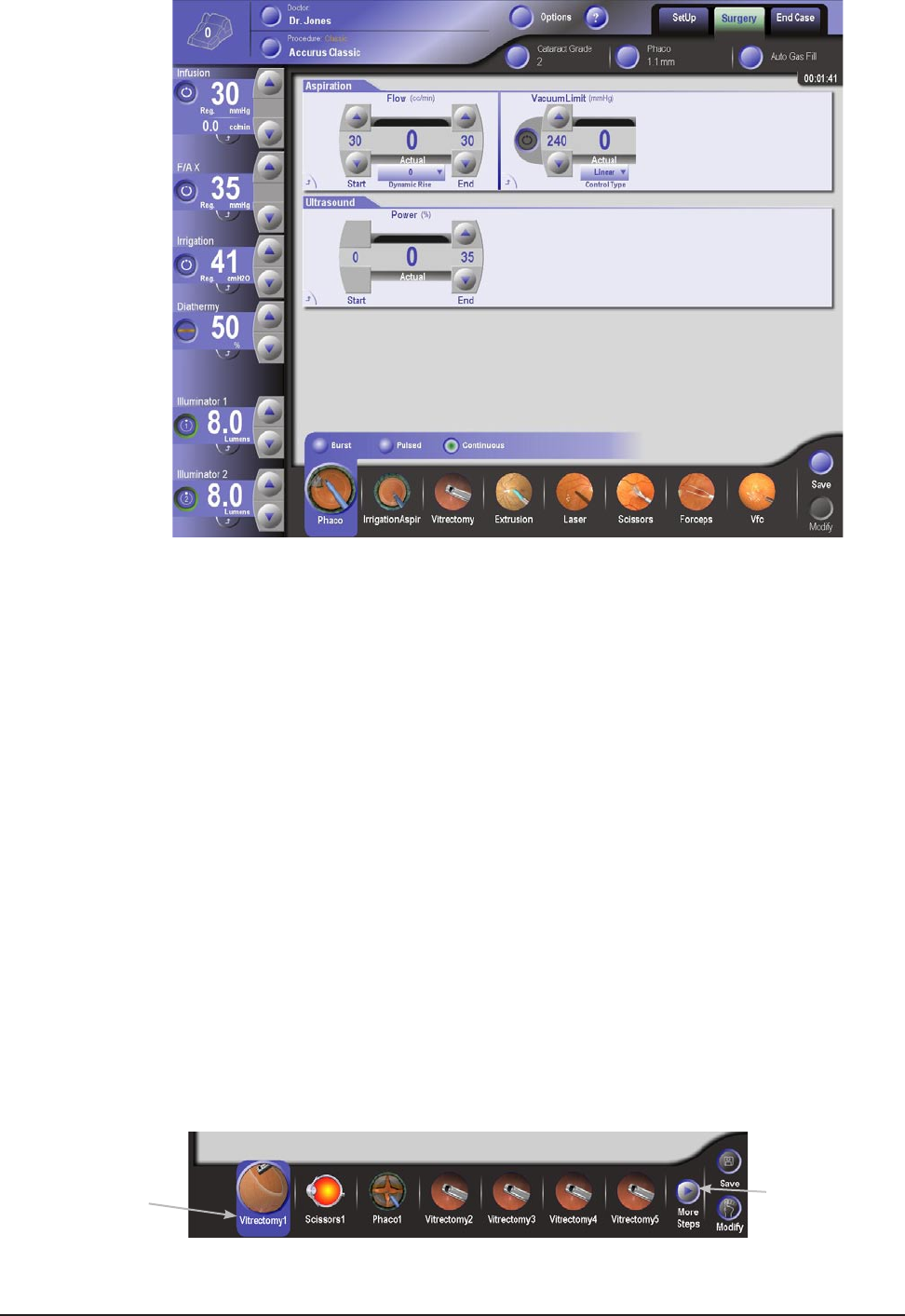
8065751025 2.63
Constellation® Vision System
Figure 2-51 Surgical Step Panel - Custom Procedure
Selected Step Scroll Button(s)
Figure 2-50 Accurus® Classic Surgery Screen
Surgery Screen: Surgical Procedures - Custom Procedure
Custom Procedures can contain any combination of steps in any order and with user
defined names as shown in Figure 2-51.
Custom Procedures are intended to contain all the steps that the user has included to
perform a certain task. However, in some cases the user may need to do something
that is not included in the current procedure. In addition to the manual method of
adding surgical steps through the Modify Procedure screen as described previously in
this section, the system automatically adds relevant step(s) when an instrument (such
as a Vitreous probe) is connected. For example if the user suddenly requires the use of
the laser, the system automatically adds a laser Step to the end of the procedure when
it detects the connection of a laser probe. Also, if a laser probe is already connected
when the procedure is selected, a laser step is added to the end of the procedure.
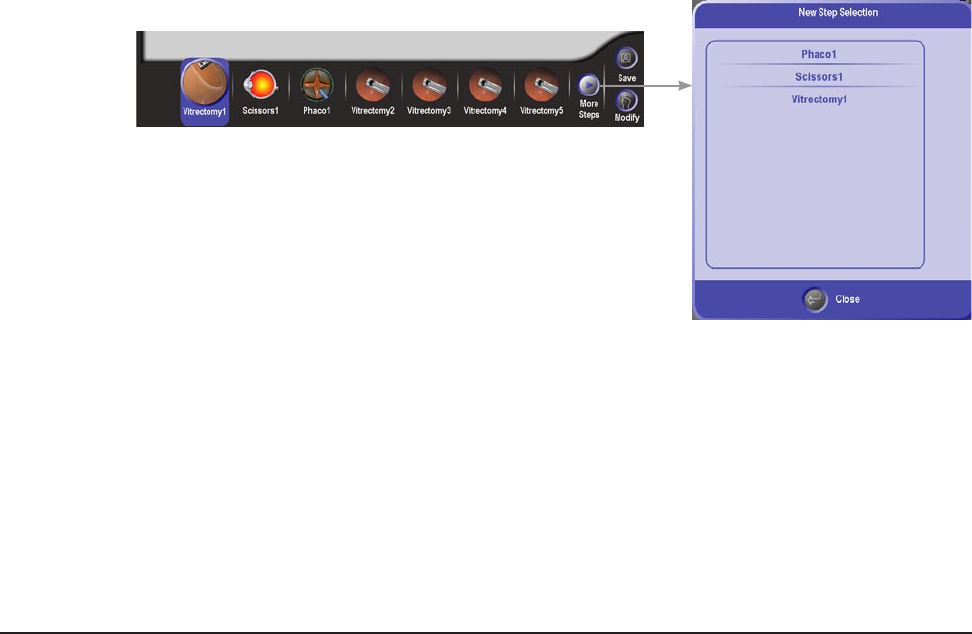
2.64 8065751025
Constellation® Vision System
Surgery Screen: The Surgical Step Panel
The Surgical Step Panel organizes the set of activities (steps) to be performed during
a surgical procedure in a left to right sequence. The procedure may be customized as
desired to meet the needs of the surgeon and the case to be performed. The Step panel
provides the following functionality:
Shows which step is currently selected (note that a step is associated with only
one surgical mode).
Shows which sub mode is currently selected for that step.
Allows the user to select a new step.
Allows the user to select a new sub mode.
Allows the user to select a “hidden” step (if applicable).
A selected step has the following properties:
The area behind the icon is highlighted in blue.
The icon is animated.
Buttons for submodes are shown above the step button.
The Step buttons act as radio buttons in that only one step at a time can be selected
and a step must always be selected at any point in time.
The Scroll Buttons allow the user to navigate to “hidden steps,” i.e. steps that are
either to the left or the right of the visible steps. The scroll buttons are only visible if
the current procedure contains more steps than can fit on the Step Panel.
Figure 2-51a shows an example of a Step Panel with three hidden steps to the right.
The Right Scroll button is enabled and pressing it displays a list of the hidden steps.
Any of the steps can be selected from the list. The selected step will be highlighted as
the selected step on the panel and placed in the rightmost position.
•
•
•
•
•
•
•
•
Figure 2-51a Surgical Step Panel Scroll Buttons
Surgery Screen: Surgical Submode Buttons
For Accurus Classic procedures, the submode buttons are always displayed as shown
in the Figure 2-49a. The submode buttons act like radio buttons (just like the step
buttons) and the currently selected sub mode is highlighted.
For Custom procedures, the submode buttons are only displayed when the user
presses the currently selected step. The submode buttons are then displayed for five
seconds enabling the user to select the desired submode. After five seconds, the
submode buttons will disappear.
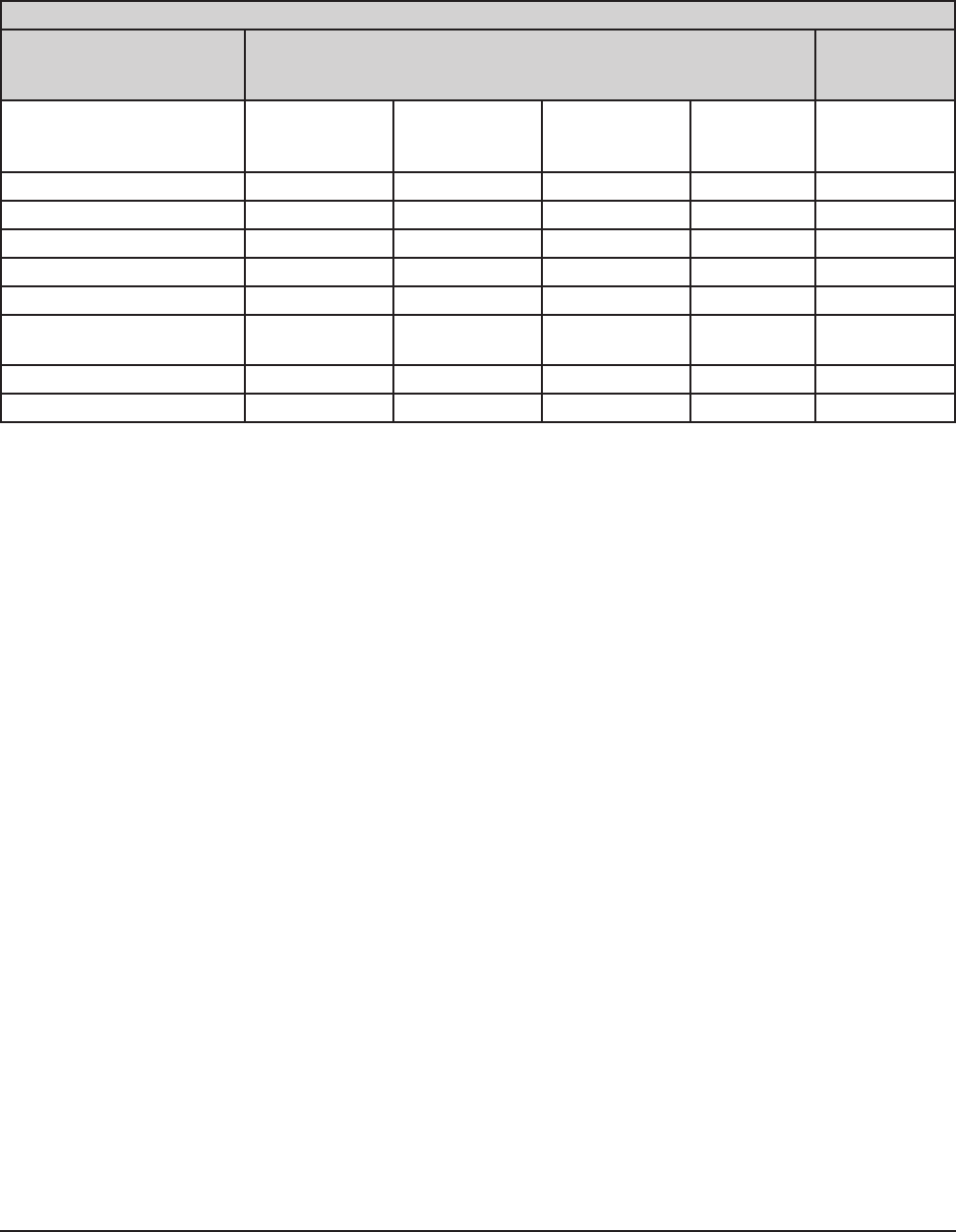
8065751025 2.65
Constellation® Vision System
SURGICAL MODES AND SUBMODES
The Constellation® Vision System offers nine surgical modes that can be customized
to meet the needs of each surgeon. Table 2-1 lists each mode and its associated
submodes.
TABLE 2-1. SURGICAL MODES AND SUBMODES
MODE SUBMODES
BIMANUAL
(Advanced
Mode)
Vitrectomy (Vit) 3D Momentary
Proportional
Vacuum
(PropVac)
Wet
(VitWet) Forceps
Phaco Burst Pulsed Continuous
Fragmentation (Frag) Fixed Linear Momentary
Irrigation/Aspiration (I/A)
Extrusion
Laser
Scissors Multicut Proportional
(Prop) Forceps
Forceps
Viscous Fluid Control (VFC) Extract Inject Vacuum
Each surgical mode has as set of associated surgical panels. Some panels can have
different displays in following cases:
Standard vs. Advanced mode - In advanced display, these panels offer more
optional controls for setting and configuring its functions. Selecting Standard or
Advanced mode is done in Options\Doctor Settings\Miscellaneous. The default
mode is Standard.
Vacuum mode vs. Flow mode - By default, the posterior modes show the vacuum
panel for vacuum mode and the anterior modes show the aspiration panel for flow
mode (if available).
Bimanual mode - Vit, scissors, and VFC modes offer the surgeon the option of
controlling two instruments simultaneously such as a vitreous probe and a pair
of forceps (in Vit mode). This is referred to as Bimanual mode and the additional
instrument is activated by pressing the “Bimanual” button.
Vitrectomy Mode
Vitrectomy mode provides vitreous cutting and vacuum using a pneumatically
powered vitrectomy probe connected by tubing to a pulsed air pressure source and a
vacuum port. Four submodes are available, each with its own default cut rate and
vacuum level. Values are adjusted using touch arrow keys, even when the footpedal is
depressed. Cutting and/or vacuum begins when the footpedal is pressed.
•
•
•
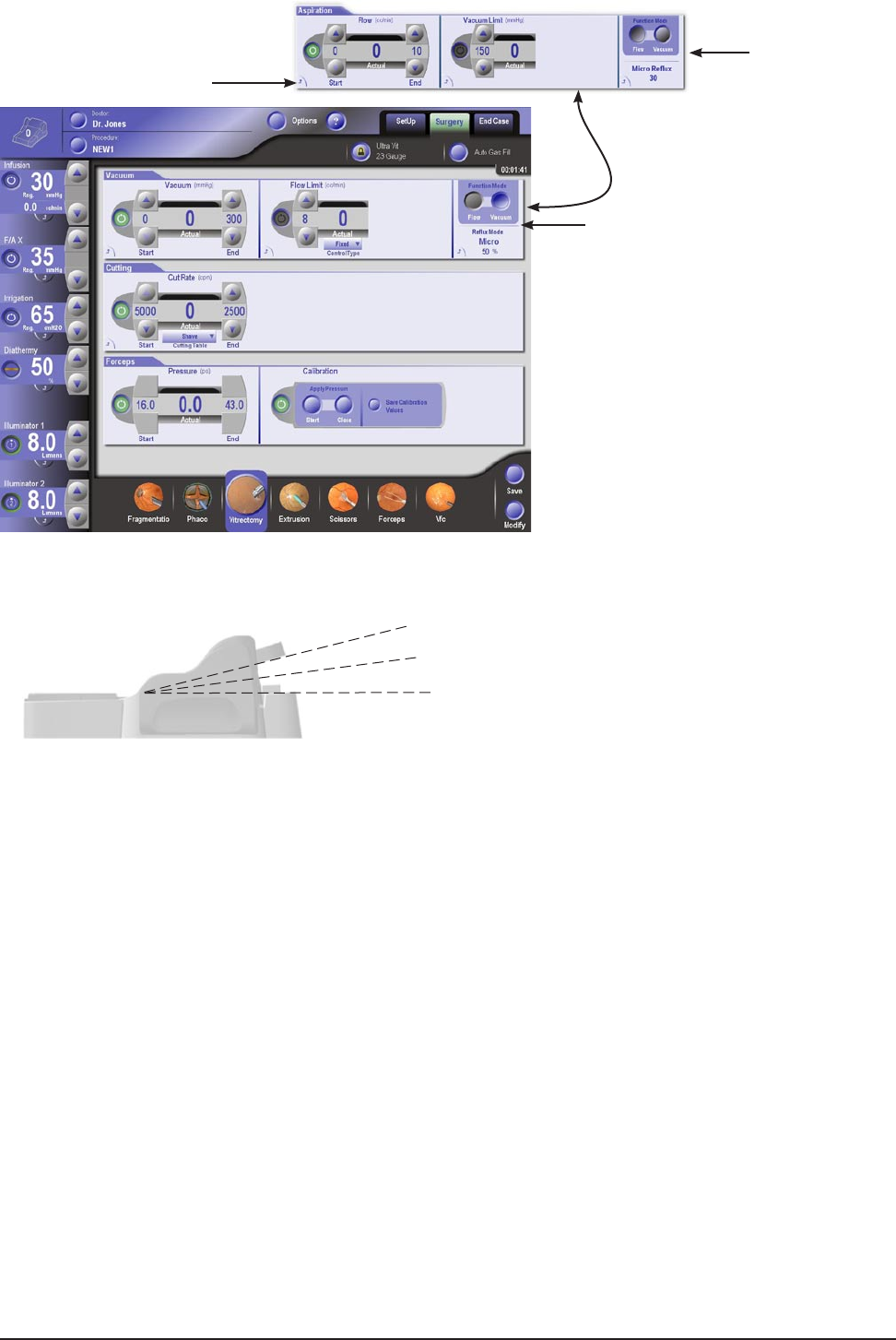
2.66 8065751025
Constellation® Vision System
Figure 2-52
Surgery Screen: Vitrectomy Mode-
3D Submode
Vitrectomy: 3D SUBMODE
In the 3D submode, the user controls both the vitreous cut rate and the vacuum
pressure linearly. This submode allows for setting the treadle start and end values for
both the cut rate and the vacuum pressure. Additionally, in Advanced Display Mode
that is shown in Figure 2-52, the Forceps End Pressure can be changed.
In 3D submode, vacuum delivered to the probe and the probe cutting rate are both
regulated by the amount of footpedal depression. The display contains adjustable
values for vacuum level at footpedal start, vacuum level at full depression; and cut
rate at footpedal start, cut rate at full depression. A unique features of this mode are:
1. Vacuum can be set to start at 0 and rise to its maximum setting at full footpedal
depression, while the cutting rate can be set to start at its maximum setting and
decrease as the footpedal is depressed (or any combination thereof).
2. To ensure that not too much flow is generated when the footpedal is first depressed,
the vacuum level is ramped up from 0 to the set starting level during the first part of
the pedal travel.
Aspiration Panel
Vacuum Panel
Configuration Button

8065751025 2.67
Constellation® Vision System
The controls for each panel in 3D submode have the following functions:
Vacuum Panel:
On/Off - Turns vacuum on or off.
Vacuum Start Up/Down Buttons - Sets the vacuum level at treadle start (3D mode
only).
Vacuum End Up/Down Buttons - Sets the vacuum level at full treadle.
Vacuum Configuration Button - Displays the configuration popup allowing
the user to make changes using slider controls. Also provides panel specific
configuration capabilities (such as drainbag change).
Cutting Panel:
Cut Rate On/Off Button - Turns the cutter on or off.
Cut Rate Start Up/Down Buttons - Sets the cut rate at treadle start.
Cut Rate End Up/Down Buttons - Sets the cut rate at full treadle.
Cutting Configuration Button - Displays the configuration dialog.
Cutting Table Drop List (Advanced view only) - Allows selection of port open
duty cycle that is appropriate for the procedure to be performed.
Core - Provides the maximum port open duty cycle control suited for core
vitrectomy where higher flow rates and efficiency are desirable.
50/50 - Provides a 50% port open duty cycle control for those users who
prefer a 50% duty cycle.
Shave - Provides the minimum port open duty cycle suited for removing
delicate tissue (such as vitreous shaving and membrane dissection) where
lower flow rates are desirable.
The following controls are available only in the Advanced view:
Flow Limit On/Off Button - Turns flow limit on or off. When the maximum rate is
reached the vacuum level can no longer be increased. If the Flow Limit is turned
off, the vacuum level is limited only by the Start and End values.
Flow Limit Up/Down Buttons - Sets the maximum flow rate.
Flow Limit Configuration Button - Displays the Flow Limit configuration popup.
Flow/Vacuum Toggle - Switches between Flow Mode and Vacuum Mode.
Reflux Label - Read Only display of the current reflux configuration together with
its current value.
Reflux Configuration Button - Displays the configuration popup that allows for
changing the current mode and the setpoint associated with it.
Aspiration Panel (Flow mode-Advanced view only):
Flow On/Off Button - Turns flow mode on or off.
Flow Start Up/Down Buttons - Sets the flow level at treadle start.
Flow End Up/Down Buttons - Sets the flow level at full treadle.
Flow Configuration Button - Displays the configuration popup for a detailed view
of the settings.
Vacuum Limit On/Off Button - Turns vacuum limit on or off. When the maximum
rate is reached, the flow can no longer be increased. If the Vacuum Limit is turned
off, the flow is limited only by the Start and End values.
Vacuum Limit Up/Down Buttons - Sets the maximum vacuum value.
Vacuum Limit Configuration Button - Displays the configuration dialog.
Flow/Vacuum Toggle - Switches between Flow Mode and Vacuum Mode.
•
•
•
•
•
•
•
•
•
•
•
•
•
•
•
•
•
•
•
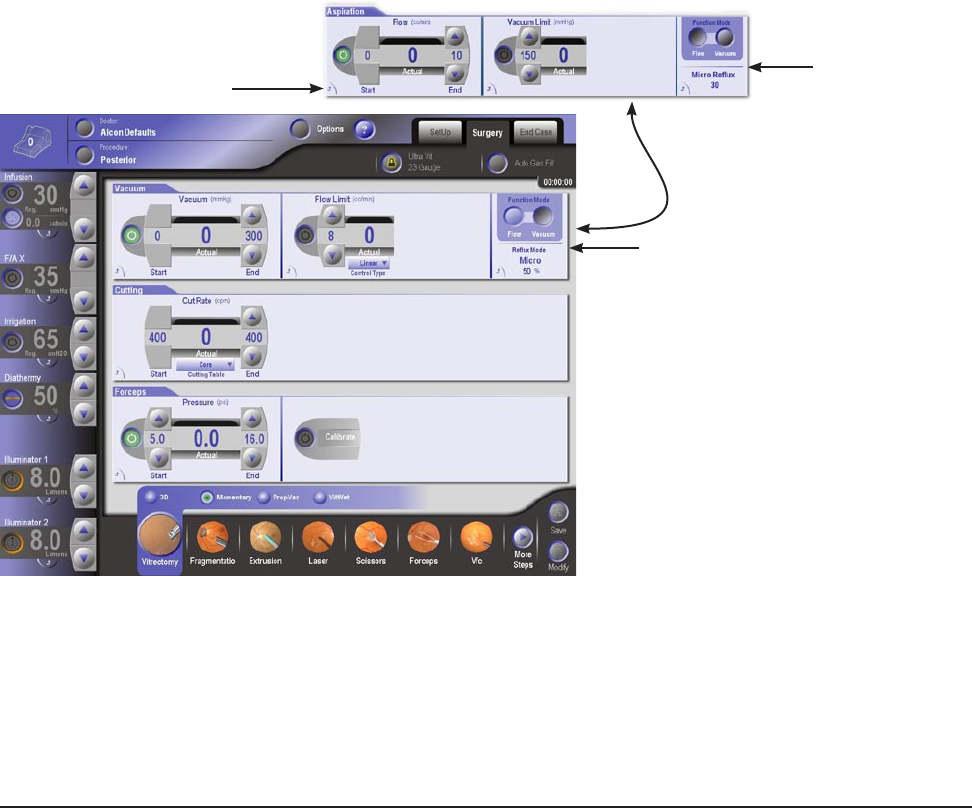
2.68 8065751025
Constellation® Vision System
Forceps Panel (Advanced view only):
Pressure On/Off Button - Turns Bimanual mode on or off. When Bimanual mode
is off the only option is to turn it on. When Bimanual mode is on, the Forceps
pressure can be set.
Pressure End Up/Down Buttons - Sets the pressure at full treadle.
Forceps Configuration Button - Displays the configuration dialog.
Calibration - When the calibration control is turned on, the control changes to one
that allows a selection between Start and Close. When Start is selected the Start
pressure is applied to the port and when Close is selected the Close pressure is
applied to the port. If neither is selected then no pressure is applied to the port.
Pressing the "Save Calibration Values" button saves the calibrated values.
Vitrectomy: MOMENTARY SUBMODE
The Momentary submode contains values for maximum vacuum limit and cut rate set
point. As the footpedal is depressed the vacuum increases linearly up to the End limit
with the actual vacuum displayed in the Actual Value box and its linear equivalent
reflected in the progress bar. The End value can be adjusted using the Up/Down
arrow buttons or selecting the Configuration button to display the Configuration
popup that has a slidebar for large numeric adjustments in vacuum.
•
•
•
•
Figure 2-53 Surgery Screen: Vitrectomy Mode-Momentary Submode
Aspiration Panel
Vacuum Panel
Configuration Button
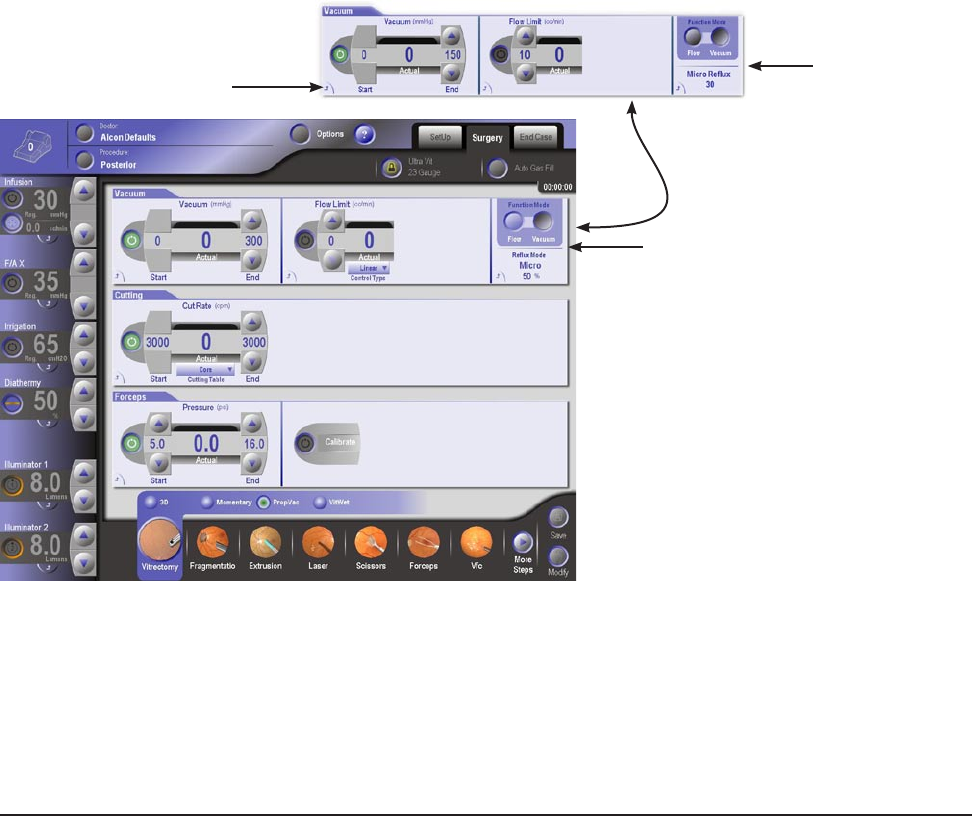
8065751025 2.69
Constellation® Vision System
Probe cutting at a preset rate is activated when the applicable footswitch switch
is momentarily activated. The default activation switch is the right horizontal switch
but may be configured differently for each doctor. To view the current configuration,
press the footswitch icon in the upper left corner of the display.
The controls for each panel in Momentary submode are the same as in 3D submode
with the following exceptions:
No Vacuum Start Up/Down buttons - Vacuum always begins at zero.
No Flow Start Up/Down buttons - Flow always begins at zero.
No Cut Rate Start Up/Down buttons - Cut rate is a constant rate set by the End
buttons and activated by the programmed switch on the footswitch.
Vitrectomy: PROPVAC SUBMODE
The Proportional Vacuum (PropVac) submode contains values for maximum vacuum
limit and cut-rate set point. As the footpedal is depressed the vacuum increases
linearly up to the End limit with the actual vacuum displayed in the Actual Value box
and its linear equivalent reflected in the progress bar. The End value can be adjusted
using the Up/Down arrow buttons or selecting the Configuration button to display the
Configuration popup that has a slidebar for large numeric adjustments in vacuum.
•
•
•
Figure 2-54 Surgery Screen: Vitrectomy Mode-PropVac Submode
Aspiration Panel
Vacuum Panel
Configuration Button
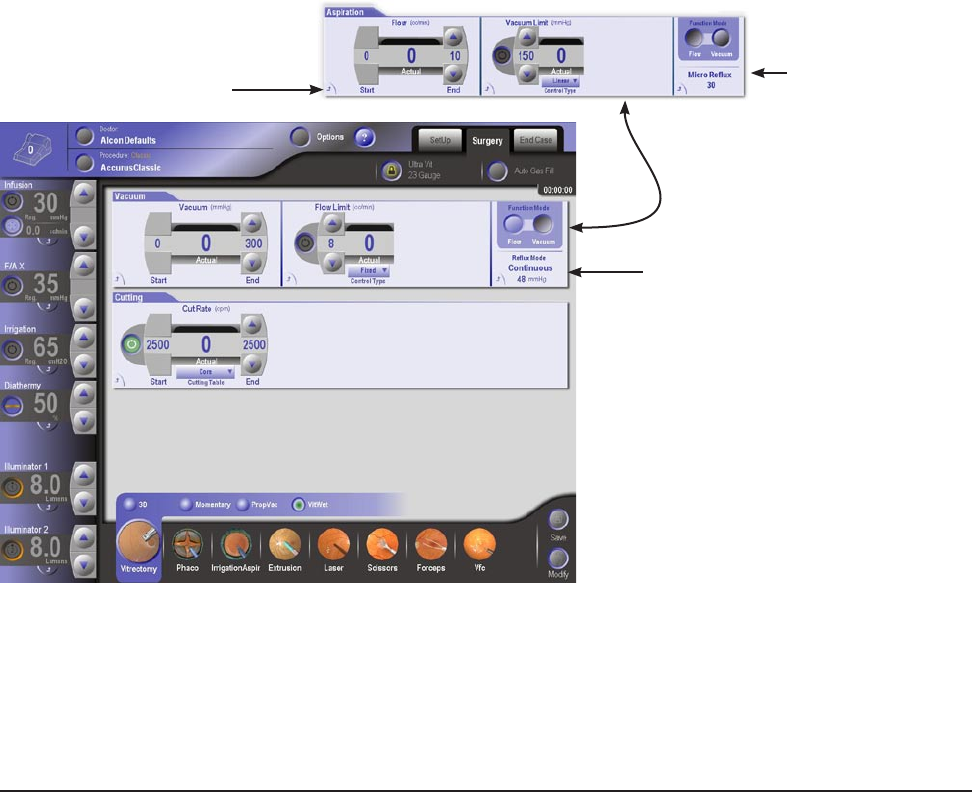
2.70 8065751025
Constellation® Vision System
Probe cutting at a preset rate begins when the footpedal is pressed. The Cut Rate
is adjusted by pressing Up/Down arrow buttons on the Cutting control or selecting the
Configuration button to display the Configuration popup that has a slidebar for large
numeric adjustments in cut rate.
The controls for each panel in PropVac submode are the same as in 3D submode with
the following exceptions:
No Vacuum Start Up/Down buttons - Vacuum always begins at zero.
No Flow Start Up/Down buttons - Flow always begins at zero.
No Cut Rate Start Up/Down buttons - Cut rate is a constant rate set by the End
buttons and activated when the footpedal is pressed.
Vitrectomy: VITWET SUBMODE
In the VitWet submode the user can control the vacuum pressure linearly. This sub
mode allows for setting the treadle end value for the vacuum pressure and the cut
rate. The start value for vacuum pressure is always zero. The start value for cut rate
is always the same as the end value. In Advanced Display Mode, the Flow Limit
Control Type can be changed.
Probe cutting at a preset rate begins when the footpedal is pressed. The Cut Rate
•
•
•
Figure 2-55 Surgery Screen: Vitrectomy Mode-VitWet Submode
Aspiration Panel
Vacuum Panel
Configuration Button

8065751025 2.71
Constellation® Vision System
is adjusted by pressing Up/Down arrow buttons on the Cutting control or selecting the
Configuration button to display the Configuration popup that has a slidebar for large
numeric adjustments in cut rate.
The controls for each panel in VitWet submode are the same as in 3D submode with
the following exceptions:
No Vacuum On/Off or Start Up/Down buttons - Vacuum always begins at zero.
No Flow Start Up/Down buttons - Flow always begins at zero.
No Cut Rate Start Up/Down buttons - Cut rate is a constant rate set by the End
buttons and activated when the footpedal is pressed.
No Forceps Panel.
Phaco Mode
Phaco mode provides phacoemulsification capabilities by using U/S powered
handpieces controlled by the footswitch. U/S power may be linearly controlled from
either zero to the operator specified value or pulsed.
When the U/S handpiece is selected, irrigation, aspiration, and phaco power are
provided to the handpiece tip. Phaco power is defined as being proportional to
ultrasound displacement of the phaco tip. Amplitude of the ultrasound displacement
of the phaco tip is proportional to the ultrasound power displayed on the console
front panel. The user has the ability to adjust the aspiration rate, vacuum levels, and
phaco power at any time during the surgical procedure via their respective adjustment
arrows or remote control.
The phaco Power Limit is increased or decreased via the front panel in increments
of 5% from a minimum of 0% to a maximum of 100%. The amount of phaco power
delivered to the handpiece is controlled by one of two methods: linear or fixed
footpedal control.
In Flow Mode, the Aspiration panel is displayed while in Vacuum Mode, the Vacuum
panel is displayed. In “Standard” display mode, only the Flow mode controls
are available. When system detects an occlusion, an alarm sounds and the word
"Occlusion" appears on the extraction panel (in either vacuum mode or flow mode)
under the primary limit control’s label.
There are four submodes available in Phaco mode
Burst
Custom
Pulsed
Continuous
Phaco Mode: BURST SUBMODE
In the Phaco Burst submode fixed U/S power (Power %) can be adjusted for duration
(On Time) and time off between (Off Time) U/S power pulses. The frequency of
bursts is controlled with the footpedal from detent two to full treadle depression,
while the fixed burst length is set in milliseconds (ms). The actual percent of time U/S
power is activated is reflected in the Actual window.
•
•
•
•
•
•
•
•
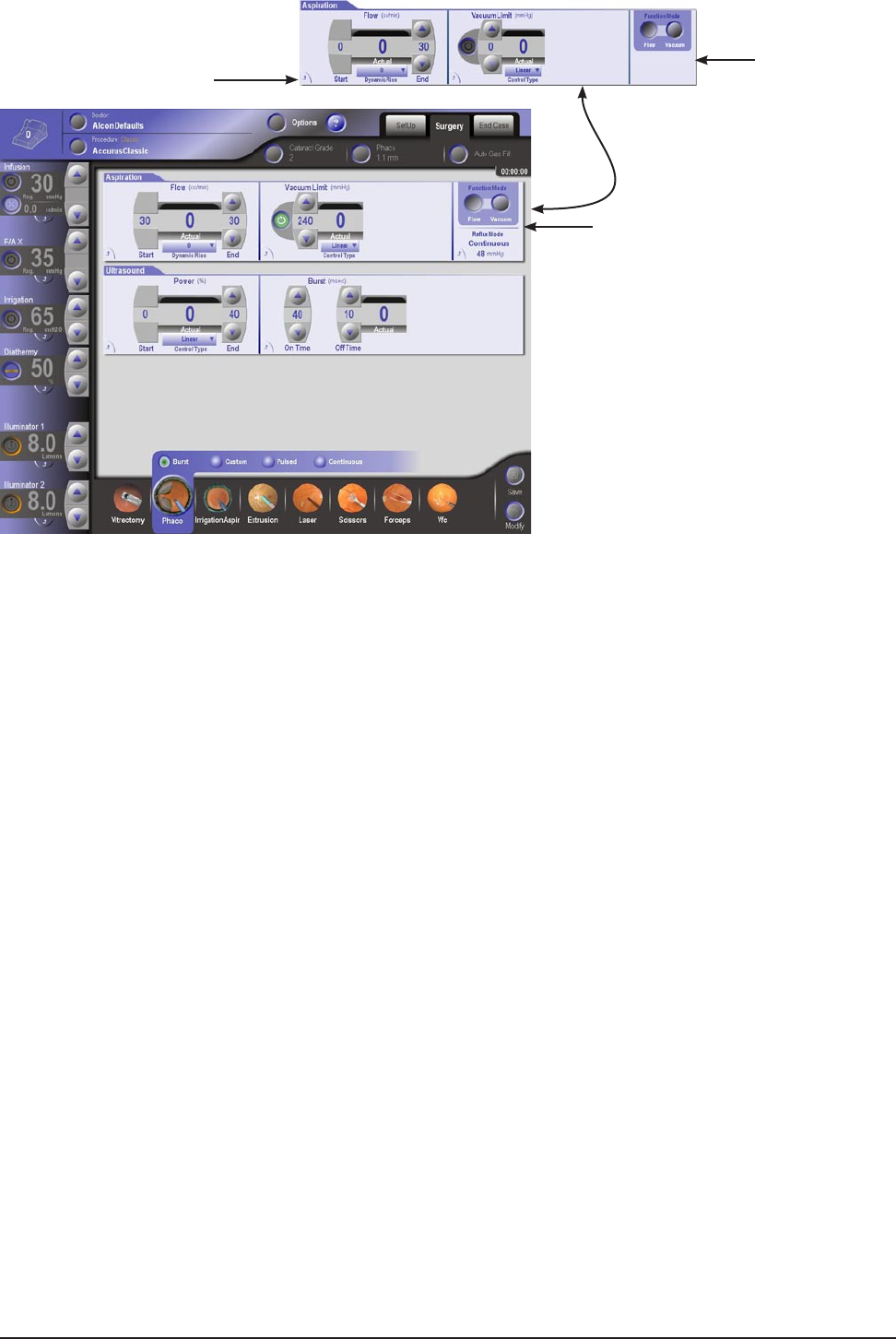
2.72 8065751025
Constellation® Vision System
The controls for each panel in Burst submode have the following functions:
Aspiration Panel:
Flow End Up/Down Buttons - Sets the flow level at full treadle.
Dynamic Rise Drop List - Select for the rise value. The rise value determines
the slope of the increase applied.
Flow Configuration Button - Displays the configuration popup.Simplifies large
value changes by providing slider controls. Also provides the capability to initiate
a drainbag change.
Vacuum Limit On/Off Button - Turns vacuum limit on or off. When the maximum
rate is reached, the flow can no longer be increased. If the Vacuum Limit is turned
off, the flow is limited only by the Start and End values.
Vacuum Limit Up/Down Buttons - Sets the maximum vacuum value.
Vacuum Limit Control Type Drop List - Determines whether the vacuum limit is
fixed or linear. In Fixed the limit is constant regardless of the vacuum level. In
Linear the limit varies depending on the vacuum level.
Vacuum Limit Configuration Button - Displays the configuration popup.
Flow/Vacuum Toggle (Advanced view only): Switch between Flow Mode and
Vacuum Mode.
Vacuum Panel:
The following controls are available only in the Advanced view only by switching
the Function Mode from Flow to Vacuum:
Vacuum End Up/Down Buttons - Sets the vacuum level at full treadle.
Vacuum Configuration Button - Displays the configuration popup. Simplifies
large value changes by providing slider controls. Also provides the capability to
•
•
•
•
•
•
•
•
•
•
Figure 2-56 Surgery Screen: Phaco Mode - Burst Submode
Aspiration Panel
Vacuum Panel
Configuration Button

8065751025 2.73
Constellation® Vision System
initiate a drainbag change.
Flow Limit On/Off Button - Turns flow limit on or off. When the maximum rate is
reached, the vacuum level can no longer be increased. If the Flow Limit is turned
off, the vacuum level is limited only by the Start and End values.
Flow Limit Up/Down Buttons - Sets the maximum flow rate.
Flow Limit Progress Bar and Numerical Value - Shows the current flow level.
Flow Limit Configuration Button - Displays the configuration popup.
Flow Limit Control Type Drop List - Determines whether the flow limit is fixed
or linear. In Fixed the limit is constant regardless of the flow level. In Linear the
limit varies depending on the flow level.
Flow/Vacuum Toggle - Switches between Flow Mode and Vacuum Mode.
Ultrasound Panel:
Power End Up/Down Buttons - Sets the power at full treadle.
Power Progress Bar and Numerical Value - Displays the current power value.
•
•
•
•
•
•
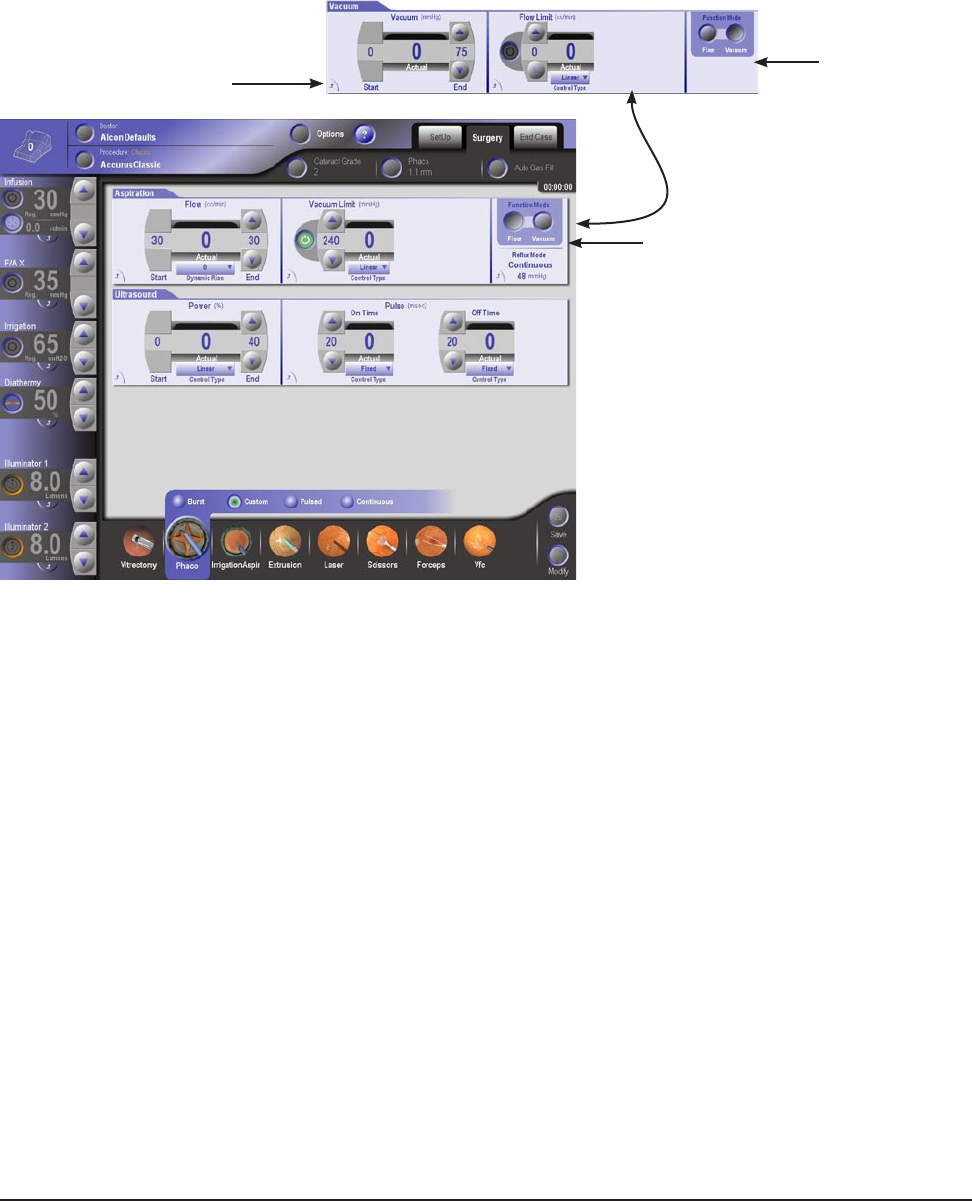
2.74 8065751025
Constellation® Vision System
Power Limit Control Type Drop List (Advanced view only) - Determines whether
the power is fixed or linear. In Fixed, the power is constant. In Linear the power
varies depending on the treadle position.
Phaco Power Configuration Button - Displays the configuration Popup. Simplifies
large value changes by providing slider controls.
Phaco Burst On Time Up/Down Buttons - Sets the Phaco burst on time.
Phaco Burst Off Time Up/Down Buttons - Sets the Phaco burst off time.
Phaco Burst Off Time Progress Bar and Numeric Value - Shows the current Phaco
•
•
•
•
Figure 2-57 Surgery Screen: Phaco Mode - Custom Submode
Aspiration Panel
Vacuum Panel
Configuration Button
burst off time.
Phaco Burst Configuration Button - Dislays the configuration popup.
Phaco Mode: CUSTOM SUBMODE
The Custom submode is only available in the Advanced view.
In the Phaco Custom submode fixed U/S power (Power %) can be adjusted for
duration (On Time) and time off between (Off Time) U/S power pulses. The
frequency of bursts is controlled with the footpedal from detent two to full treadle
depression, while the fixed burst length is set in milliseconds (ms). The actual percent
of time U/S power is activated is reflected in the Actual window.
The controls for each panel in Custom submode have the following functions:
Aspiration Panel:
Same as Burst submode.
Vacuum Panel:
•

8065751025 2.75
Constellation® Vision System
Same as Burst submode.
Ultrasound Panel:
Phaco Power End Up/Down Buttons - Sets the power at full treadle.
Phaco Power Progress Bar and Numerical Value - Shows the current power value.
Phaco Power Limit Control Drop Down List - Determines whether the power
is fixed or linear. In Fixed the power is constant regardless. In Linear the power
varies depending on the treadle position.
Smart Pulse - Indicator for smart pulse becomes visible when power is greater
than 0 and pulse on time is less than 20ms
Phaco Power Configuration Button - Displays the configuration popup. Simplifies
large value changes by providing slider controls.
Phaco Pulse On Time Up/Down Buttons - Sets the Phaco pulse on time.
Phaco Pulse On Time Progress Bar and Numeric Value - Shows the current Phaco
pulse on time.
Phaco Pulse On Time Limit Control Drop Down List - Determines whether the
pulse on time pulse type limit is decreasing, fixed, or increasing. In Fixed the limit
•
•
•
•
•
•
•
•